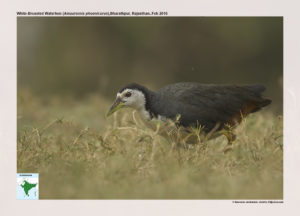White-breasted Waterhen

White-breasted Waterhen Amaurornis phoenicurus
Etymology:
- Amaurornis : Greek word amauros dusky, brown; ornis – Bird
- Phoenicurus : Greek word phoinix –crimson, red, purple; ouros –tailed
Vernacular Names: Sind: Kuraki, Hindi: Dawak, Dahak, Dauk, Jalmurghi, Sans: Shwetkanthjal kukkuti, Pun: Chitthikki jal-kukri, UP: Kinati, Bi: Ban murghi, M.P: Jal murghi, Gond: Kureyn, Ben: Panpaira, Ass: Dauk, Mani: Uren konthou, Guj: Davak, Safed chatri, Mar: Kukud kombdi, Lazari pankombdi, Pandharya chatichi pankombdi, Ori: Kumhatua, Ta: Kanaan kozhi, Te: Buda kodi, Tellabora neeti kodi, Mal: Kula kozhi, Kan: Bili edeya neeru koli, Andaman: Jangli murghi, Nicobar: Takoor, Sinh: Korowaka
Distribution in India: Widespread resident in India
Description: Size of 28–33 cm; wt. of male is 203–328 g, wt. of female is 166–225 g; wingspan is 49 cm. It is a relatively large, distinctive species; unmistakable, with combination of dark slate grey upperparts and flanks, prominent white face and underparts, and rufous-cinnamon rear flanks, vent and undertail-coverts. The female is smaller, with duller bill. In non-breeding season, male’s bill becomes olive, washed brown on upper mandible. The immature is duller than adult: upperparts more olive-brown, white of face obscured by brown feather tips; underparts tinged brownish; rufous areas are duller; bill is darker and duller. The juvenile is similar but white of underparts, especially chin, throat and sides of breast, more heavily tinged dull brown; bill is dark; legs and feet brownish yellow.
Habitat: It is found in reedy or grassy swamps, marshes, tall grass with reeds and shrubs, bamboo stands, wet scrub, rice fields and sugar cane, sewage ponds, and shores of rivers, ponds, ditches and lakes, thick forest, forest edges and clearings, mangrove swamps, and scrub and bushes far from water. It is found from lowlands up to 2000 m.
Food habits: It eats Worms, molluscs, insects and their larvae, spiders and small fish, grass seeds, and shoots and roots. It is very bold. It gleans from ground; pecks seeds from standing grass. It forages in the open along water margins; feeds on beaches at low tide. It climbs in bushes and trees, swims, and occasionally dives.
Breeding habits: They breed in Jun- Oct in India and Pakistan, Apr-Oct in Ryukyu, Jan-May in Sumatra and all months in Java,. They are monogamous, with pair-bond at least for duration of breeding season. The nest is a shallow cup-shaped pad of twigs, creeper stems and leaves, placed on ground in grass or tangled undergrowth at margin of pond, ditch or flooded rice field, or concealed in shrub or in bamboo clump up to 2 m above ground. They lay a clutch of 4-9 eggs. The incubation period is 20 days and incubation is done by both sexes. The chicks leave nest soon after hatching and are fed and cared for by both parents.